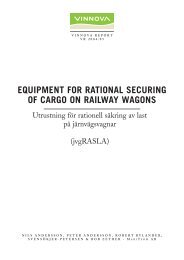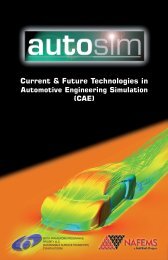WP3: Rail Passenger Transport - TOSCA Project
WP3: Rail Passenger Transport - TOSCA Project
WP3: Rail Passenger Transport - TOSCA Project
Create successful ePaper yourself
Turn your PDF publications into a flip-book with our unique Google optimized e-Paper software.
Table 5-4b<br />
Cost characteristics for high-speed train services (electric),<br />
as estimated by 2050, compared with reference train (2009).<br />
Note: In this table energy cost is excluded from operating cost, but is indicated as the expected<br />
amount of energy consumption per passenger-km (pkm).<br />
Sales price<br />
(MEUR / train unit)<br />
Estimated<br />
Operating cost d<br />
(EUR / pass-km)<br />
Variation<br />
Estimated<br />
Variation<br />
Energy e<br />
(MJ /pkm)<br />
Most<br />
likely<br />
Reference high-speed train a 28 ±3 0.063 ±0.010 0.243<br />
1. PA Low-drag b 28.5 ±3.5 0.064 b ±0.010 0.203<br />
2. PB Low-mass --- --- --- --- ---<br />
3. PC Energy recovery 28 ±3 0.063 ±0.010 0.236<br />
4. PD Space efficiency 24.5 c ±3 0.058 ±0.010 0.213<br />
5. PF Eco-driving 28.1 ±3 0.062 ±0.010 0.220<br />
6. Pcomb electric + incremental 25 ±3.5 0.058 ±0.011 0.126<br />
7. Pcomb HS: (6) + higher speed 28 ±4 0.057 ±0.011 0.165<br />
a<br />
At the reference year high-speed trains is estimated to have a market share of 20 % on the rail passenger<br />
market; are however anticipated to increase until 2050.<br />
b For high-speed trains it is assumed that a ‘Low-drag’ train will have 3 % less number seats due to longer front<br />
and tail and also 2 % higher price than the reference train.<br />
c Sales price recalculated for the equivalent number of seats. See note c) of Table 5-2.<br />
d Operating costs include capital, maintenance, crew, track & station & dispatch, train formation, sales and<br />
administration. Capital cost excludes profit margins.<br />
e Energy intake to railway’s electric supply system, from public grid.<br />
At the reference year 2009, the average cost of electric energy in EU-27 (taken from power grid) is<br />
0.091 EUR /kWh or 0.025 EUR /MJ, taxes excluded.<br />
Sales price evolution over time<br />
<strong>Rail</strong> passenger vehicles are usually developed “on behalf” a specific market or customer, for<br />
series of 100–1000 four-axle vehicles. Development cost is distributed over the actual number<br />
of vehicles. For smaller series the sales price therefore will be higher. Typically, 40 vehicles<br />
instead of 400 typically increase the per-unit price by 15–20 %, but this is of course dependent<br />
on the level of development cost. For early technologies there is also a small “learning” effect,<br />
so that production cost declines over time with each doubling of cumulative output. This effect<br />
is estimated to be 10–15 % over a time span of 10–15 years, but very often new technologies<br />
are more efficient and the older (and more inexpensive) technologies would become obsolete<br />
anyhow. These conditions for the rail vehicle market are anticipated to essentially continue in<br />
the future.<br />
Deliverable D4 – <strong>WP3</strong> passenger 27
















